Comparison between D-block and S-block
VerifiedAdded on 2019/09/30
|10
|2739
|486
Essay
AI Summary
The assignment content discusses the different forms of the periodic table, including Mendeleev's long format, Benfey's Spiral Table, and Janet's Left Step Table. The Mendeleev format is beneficial for predicting properties and ordering elements by atomic number. Benfey's Spiral Table offers a clear depiction of group names and electron configuration, but lacks information on atomic mass and numbers. Janet's Left Step Table is an alternative to traditional periodic tables, displaying energy levels of atoms and electronic configurations. Each table has its advantages and limitations, making it essential for chemists to understand the different forms of the periodic table.
Contribute Materials
Your contribution can guide someone’s learning journey. Share your
documents today.

Running Head: Blog writing
Blog writing
Blog writing
Secure Best Marks with AI Grader
Need help grading? Try our AI Grader for instant feedback on your assignments.
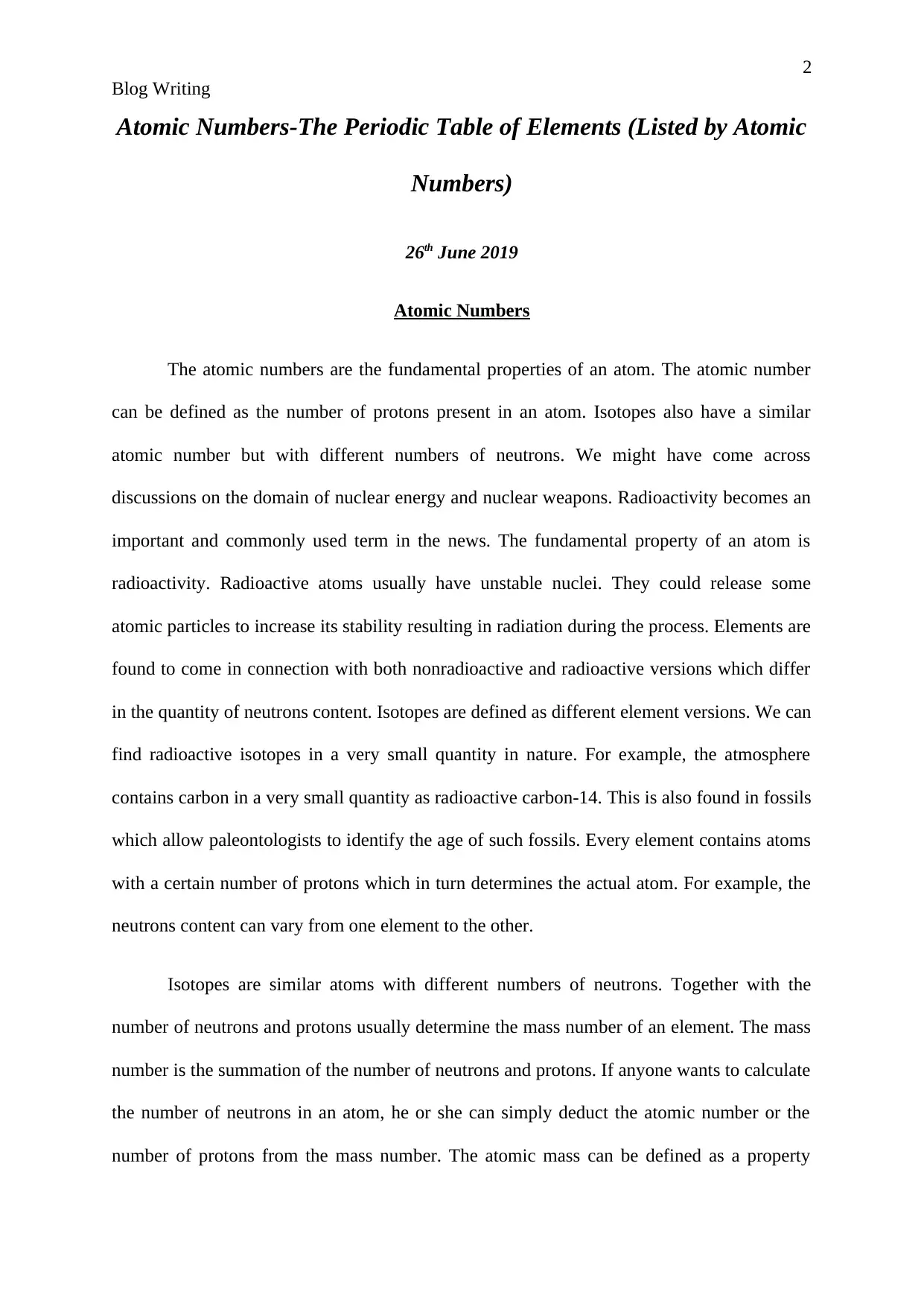
2
Blog Writing
Atomic Numbers-The Periodic Table of Elements (Listed by Atomic
Numbers)
26th June 2019
Atomic Numbers
The atomic numbers are the fundamental properties of an atom. The atomic number
can be defined as the number of protons present in an atom. Isotopes also have a similar
atomic number but with different numbers of neutrons. We might have come across
discussions on the domain of nuclear energy and nuclear weapons. Radioactivity becomes an
important and commonly used term in the news. The fundamental property of an atom is
radioactivity. Radioactive atoms usually have unstable nuclei. They could release some
atomic particles to increase its stability resulting in radiation during the process. Elements are
found to come in connection with both nonradioactive and radioactive versions which differ
in the quantity of neutrons content. Isotopes are defined as different element versions. We can
find radioactive isotopes in a very small quantity in nature. For example, the atmosphere
contains carbon in a very small quantity as radioactive carbon-14. This is also found in fossils
which allow paleontologists to identify the age of such fossils. Every element contains atoms
with a certain number of protons which in turn determines the actual atom. For example, the
neutrons content can vary from one element to the other.
Isotopes are similar atoms with different numbers of neutrons. Together with the
number of neutrons and protons usually determine the mass number of an element. The mass
number is the summation of the number of neutrons and protons. If anyone wants to calculate
the number of neutrons in an atom, he or she can simply deduct the atomic number or the
number of protons from the mass number. The atomic mass can be defined as a property
Blog Writing
Atomic Numbers-The Periodic Table of Elements (Listed by Atomic
Numbers)
26th June 2019
Atomic Numbers
The atomic numbers are the fundamental properties of an atom. The atomic number
can be defined as the number of protons present in an atom. Isotopes also have a similar
atomic number but with different numbers of neutrons. We might have come across
discussions on the domain of nuclear energy and nuclear weapons. Radioactivity becomes an
important and commonly used term in the news. The fundamental property of an atom is
radioactivity. Radioactive atoms usually have unstable nuclei. They could release some
atomic particles to increase its stability resulting in radiation during the process. Elements are
found to come in connection with both nonradioactive and radioactive versions which differ
in the quantity of neutrons content. Isotopes are defined as different element versions. We can
find radioactive isotopes in a very small quantity in nature. For example, the atmosphere
contains carbon in a very small quantity as radioactive carbon-14. This is also found in fossils
which allow paleontologists to identify the age of such fossils. Every element contains atoms
with a certain number of protons which in turn determines the actual atom. For example, the
neutrons content can vary from one element to the other.
Isotopes are similar atoms with different numbers of neutrons. Together with the
number of neutrons and protons usually determine the mass number of an element. The mass
number is the summation of the number of neutrons and protons. If anyone wants to calculate
the number of neutrons in an atom, he or she can simply deduct the atomic number or the
number of protons from the mass number. The atomic mass can be defined as a property
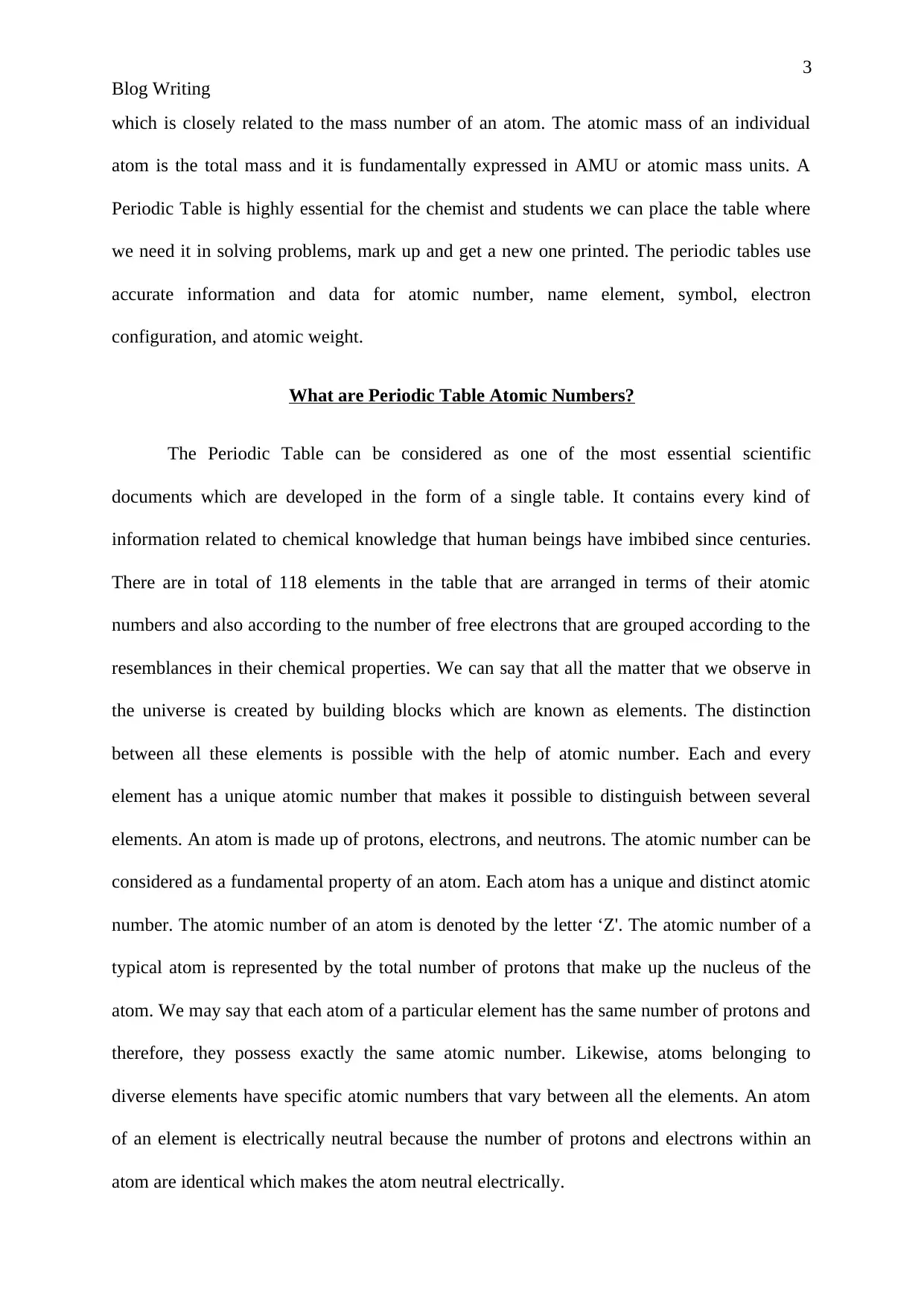
3
Blog Writing
which is closely related to the mass number of an atom. The atomic mass of an individual
atom is the total mass and it is fundamentally expressed in AMU or atomic mass units. A
Periodic Table is highly essential for the chemist and students we can place the table where
we need it in solving problems, mark up and get a new one printed. The periodic tables use
accurate information and data for atomic number, name element, symbol, electron
configuration, and atomic weight.
What are Periodic Table Atomic Numbers?
The Periodic Table can be considered as one of the most essential scientific
documents which are developed in the form of a single table. It contains every kind of
information related to chemical knowledge that human beings have imbibed since centuries.
There are in total of 118 elements in the table that are arranged in terms of their atomic
numbers and also according to the number of free electrons that are grouped according to the
resemblances in their chemical properties. We can say that all the matter that we observe in
the universe is created by building blocks which are known as elements. The distinction
between all these elements is possible with the help of atomic number. Each and every
element has a unique atomic number that makes it possible to distinguish between several
elements. An atom is made up of protons, electrons, and neutrons. The atomic number can be
considered as a fundamental property of an atom. Each atom has a unique and distinct atomic
number. The atomic number of an atom is denoted by the letter ‘Z'. The atomic number of a
typical atom is represented by the total number of protons that make up the nucleus of the
atom. We may say that each atom of a particular element has the same number of protons and
therefore, they possess exactly the same atomic number. Likewise, atoms belonging to
diverse elements have specific atomic numbers that vary between all the elements. An atom
of an element is electrically neutral because the number of protons and electrons within an
atom are identical which makes the atom neutral electrically.
Blog Writing
which is closely related to the mass number of an atom. The atomic mass of an individual
atom is the total mass and it is fundamentally expressed in AMU or atomic mass units. A
Periodic Table is highly essential for the chemist and students we can place the table where
we need it in solving problems, mark up and get a new one printed. The periodic tables use
accurate information and data for atomic number, name element, symbol, electron
configuration, and atomic weight.
What are Periodic Table Atomic Numbers?
The Periodic Table can be considered as one of the most essential scientific
documents which are developed in the form of a single table. It contains every kind of
information related to chemical knowledge that human beings have imbibed since centuries.
There are in total of 118 elements in the table that are arranged in terms of their atomic
numbers and also according to the number of free electrons that are grouped according to the
resemblances in their chemical properties. We can say that all the matter that we observe in
the universe is created by building blocks which are known as elements. The distinction
between all these elements is possible with the help of atomic number. Each and every
element has a unique atomic number that makes it possible to distinguish between several
elements. An atom is made up of protons, electrons, and neutrons. The atomic number can be
considered as a fundamental property of an atom. Each atom has a unique and distinct atomic
number. The atomic number of an atom is denoted by the letter ‘Z'. The atomic number of a
typical atom is represented by the total number of protons that make up the nucleus of the
atom. We may say that each atom of a particular element has the same number of protons and
therefore, they possess exactly the same atomic number. Likewise, atoms belonging to
diverse elements have specific atomic numbers that vary between all the elements. An atom
of an element is electrically neutral because the number of protons and electrons within an
atom are identical which makes the atom neutral electrically.

4
Blog Writing
Blog Writing
Secure Best Marks with AI Grader
Need help grading? Try our AI Grader for instant feedback on your assignments.

5
Blog Writing
“Atomic Number = No. of Protons = No. of Electrons”
History of the Periodic Table
The history of the periodic table dates back to centuries. There have been quite a
number of iterations in the table before the final one that we use today has been developed.
The first version of the periodic table was an attempt made by Antoine Lavoisier in the year
1789 where he published a list containing 33 chemical elements. These elements were
grouped into categories of earth, metals, non-metals, and gases. Then, it was in the year 1829
that Johann Wolfgang tried to make some amendments to this table by undertaking an
approach where he tried to observe the resemblances existing in the chemical properties of
the triads of elements and then grouped them which gave rise to the Law of Triads. A number
of revisions were made by the chemists to the periodic table yet, the current groupings of the
elements were not achieved. Furthermore, it was in the year 1862 that Alexandre-Émile
Béguyer de Chancourtois came up with a helix format of the periodic table. In this format, the
elements have been arranged in the form of a spiral on a cylinder and it was an attempt to
indicate the periodicity in the properties of the elements for the first time. It is interesting to
learn that Chancourtois indexed the elements in the table by enhancing the atomic weight and
demonstrating that identical chemical properties were being reflected at regular intervals.
But, unfortunately, his work did not receive adequate critical acclaim around the world. But,
the globally accepted periodic table that we now know of was developed by Dmitri
Mendeleev, a Russian scientist in the year 1871. The globally accepted periodic table that we
consult today is composed of eight columns, each one consisting of elements with identical
properties. The columns are numbered from I to VIII and contain empty spaces for including
undiscovered elements. Mendeleev's prediction was right as more and more elements were
being discovered by chemists that kept on filling the gaps in the periodic table.
Blog Writing
“Atomic Number = No. of Protons = No. of Electrons”
History of the Periodic Table
The history of the periodic table dates back to centuries. There have been quite a
number of iterations in the table before the final one that we use today has been developed.
The first version of the periodic table was an attempt made by Antoine Lavoisier in the year
1789 where he published a list containing 33 chemical elements. These elements were
grouped into categories of earth, metals, non-metals, and gases. Then, it was in the year 1829
that Johann Wolfgang tried to make some amendments to this table by undertaking an
approach where he tried to observe the resemblances existing in the chemical properties of
the triads of elements and then grouped them which gave rise to the Law of Triads. A number
of revisions were made by the chemists to the periodic table yet, the current groupings of the
elements were not achieved. Furthermore, it was in the year 1862 that Alexandre-Émile
Béguyer de Chancourtois came up with a helix format of the periodic table. In this format, the
elements have been arranged in the form of a spiral on a cylinder and it was an attempt to
indicate the periodicity in the properties of the elements for the first time. It is interesting to
learn that Chancourtois indexed the elements in the table by enhancing the atomic weight and
demonstrating that identical chemical properties were being reflected at regular intervals.
But, unfortunately, his work did not receive adequate critical acclaim around the world. But,
the globally accepted periodic table that we now know of was developed by Dmitri
Mendeleev, a Russian scientist in the year 1871. The globally accepted periodic table that we
consult today is composed of eight columns, each one consisting of elements with identical
properties. The columns are numbered from I to VIII and contain empty spaces for including
undiscovered elements. Mendeleev's prediction was right as more and more elements were
being discovered by chemists that kept on filling the gaps in the periodic table.
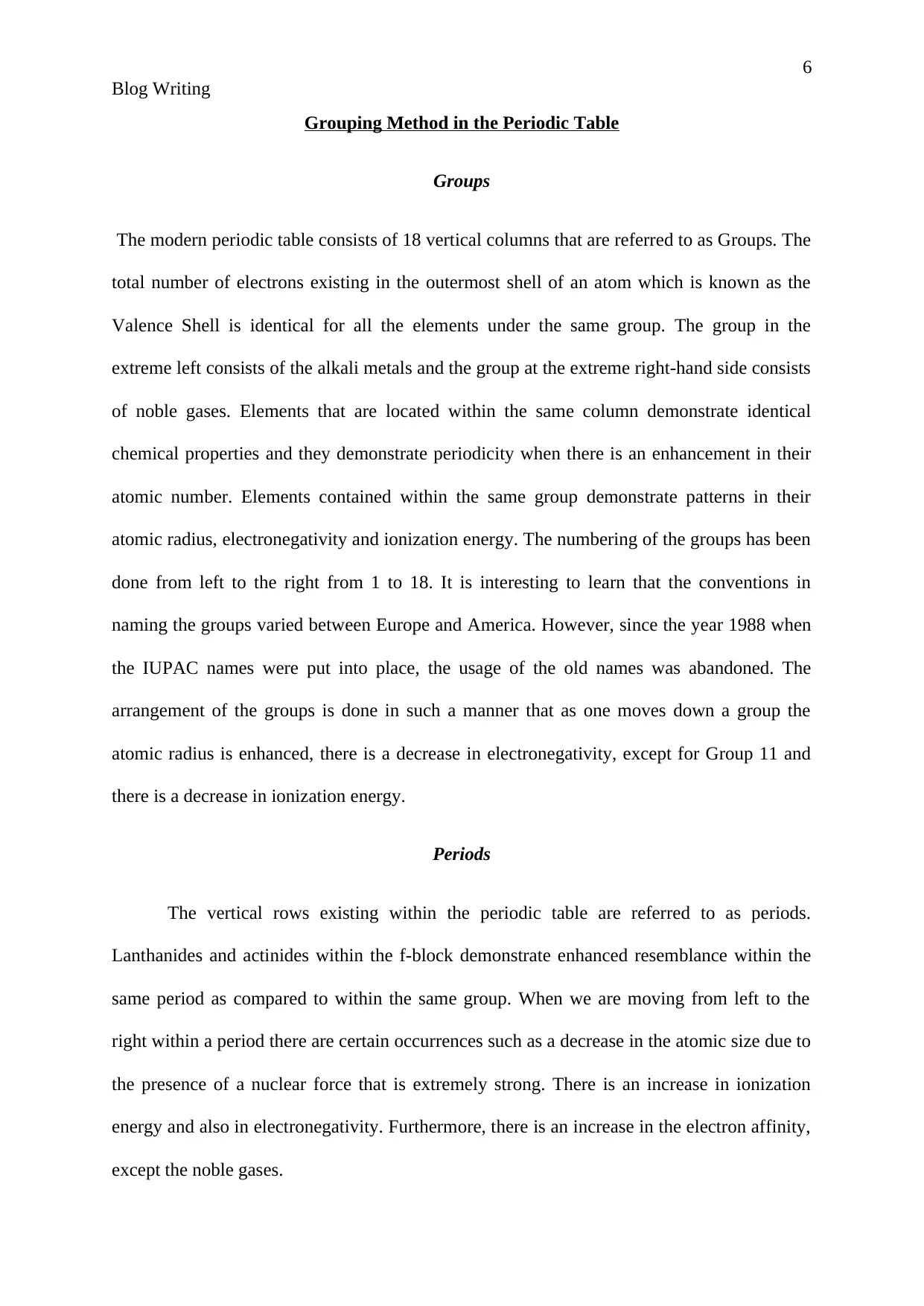
6
Blog Writing
Grouping Method in the Periodic Table
Groups
The modern periodic table consists of 18 vertical columns that are referred to as Groups. The
total number of electrons existing in the outermost shell of an atom which is known as the
Valence Shell is identical for all the elements under the same group. The group in the
extreme left consists of the alkali metals and the group at the extreme right-hand side consists
of noble gases. Elements that are located within the same column demonstrate identical
chemical properties and they demonstrate periodicity when there is an enhancement in their
atomic number. Elements contained within the same group demonstrate patterns in their
atomic radius, electronegativity and ionization energy. The numbering of the groups has been
done from left to the right from 1 to 18. It is interesting to learn that the conventions in
naming the groups varied between Europe and America. However, since the year 1988 when
the IUPAC names were put into place, the usage of the old names was abandoned. The
arrangement of the groups is done in such a manner that as one moves down a group the
atomic radius is enhanced, there is a decrease in electronegativity, except for Group 11 and
there is a decrease in ionization energy.
Periods
The vertical rows existing within the periodic table are referred to as periods.
Lanthanides and actinides within the f-block demonstrate enhanced resemblance within the
same period as compared to within the same group. When we are moving from left to the
right within a period there are certain occurrences such as a decrease in the atomic size due to
the presence of a nuclear force that is extremely strong. There is an increase in ionization
energy and also in electronegativity. Furthermore, there is an increase in the electron affinity,
except the noble gases.
Blog Writing
Grouping Method in the Periodic Table
Groups
The modern periodic table consists of 18 vertical columns that are referred to as Groups. The
total number of electrons existing in the outermost shell of an atom which is known as the
Valence Shell is identical for all the elements under the same group. The group in the
extreme left consists of the alkali metals and the group at the extreme right-hand side consists
of noble gases. Elements that are located within the same column demonstrate identical
chemical properties and they demonstrate periodicity when there is an enhancement in their
atomic number. Elements contained within the same group demonstrate patterns in their
atomic radius, electronegativity and ionization energy. The numbering of the groups has been
done from left to the right from 1 to 18. It is interesting to learn that the conventions in
naming the groups varied between Europe and America. However, since the year 1988 when
the IUPAC names were put into place, the usage of the old names was abandoned. The
arrangement of the groups is done in such a manner that as one moves down a group the
atomic radius is enhanced, there is a decrease in electronegativity, except for Group 11 and
there is a decrease in ionization energy.
Periods
The vertical rows existing within the periodic table are referred to as periods.
Lanthanides and actinides within the f-block demonstrate enhanced resemblance within the
same period as compared to within the same group. When we are moving from left to the
right within a period there are certain occurrences such as a decrease in the atomic size due to
the presence of a nuclear force that is extremely strong. There is an increase in ionization
energy and also in electronegativity. Furthermore, there is an increase in the electron affinity,
except the noble gases.
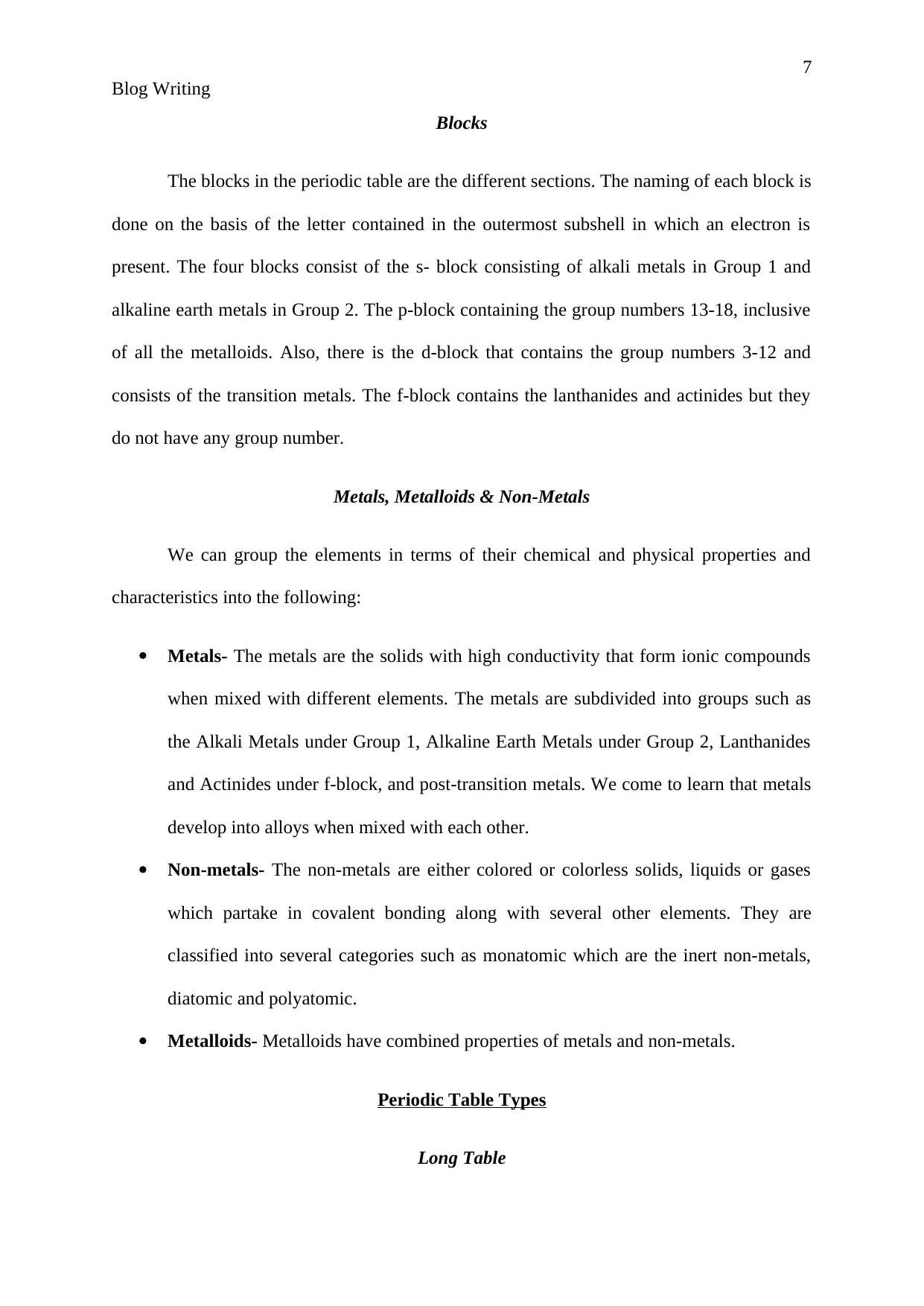
7
Blog Writing
Blocks
The blocks in the periodic table are the different sections. The naming of each block is
done on the basis of the letter contained in the outermost subshell in which an electron is
present. The four blocks consist of the s- block consisting of alkali metals in Group 1 and
alkaline earth metals in Group 2. The p-block containing the group numbers 13-18, inclusive
of all the metalloids. Also, there is the d-block that contains the group numbers 3-12 and
consists of the transition metals. The f-block contains the lanthanides and actinides but they
do not have any group number.
Metals, Metalloids & Non-Metals
We can group the elements in terms of their chemical and physical properties and
characteristics into the following:
Metals- The metals are the solids with high conductivity that form ionic compounds
when mixed with different elements. The metals are subdivided into groups such as
the Alkali Metals under Group 1, Alkaline Earth Metals under Group 2, Lanthanides
and Actinides under f-block, and post-transition metals. We come to learn that metals
develop into alloys when mixed with each other.
Non-metals- The non-metals are either colored or colorless solids, liquids or gases
which partake in covalent bonding along with several other elements. They are
classified into several categories such as monatomic which are the inert non-metals,
diatomic and polyatomic.
Metalloids- Metalloids have combined properties of metals and non-metals.
Periodic Table Types
Long Table
Blog Writing
Blocks
The blocks in the periodic table are the different sections. The naming of each block is
done on the basis of the letter contained in the outermost subshell in which an electron is
present. The four blocks consist of the s- block consisting of alkali metals in Group 1 and
alkaline earth metals in Group 2. The p-block containing the group numbers 13-18, inclusive
of all the metalloids. Also, there is the d-block that contains the group numbers 3-12 and
consists of the transition metals. The f-block contains the lanthanides and actinides but they
do not have any group number.
Metals, Metalloids & Non-Metals
We can group the elements in terms of their chemical and physical properties and
characteristics into the following:
Metals- The metals are the solids with high conductivity that form ionic compounds
when mixed with different elements. The metals are subdivided into groups such as
the Alkali Metals under Group 1, Alkaline Earth Metals under Group 2, Lanthanides
and Actinides under f-block, and post-transition metals. We come to learn that metals
develop into alloys when mixed with each other.
Non-metals- The non-metals are either colored or colorless solids, liquids or gases
which partake in covalent bonding along with several other elements. They are
classified into several categories such as monatomic which are the inert non-metals,
diatomic and polyatomic.
Metalloids- Metalloids have combined properties of metals and non-metals.
Periodic Table Types
Long Table
Paraphrase This Document
Need a fresh take? Get an instant paraphrase of this document with our AI Paraphraser
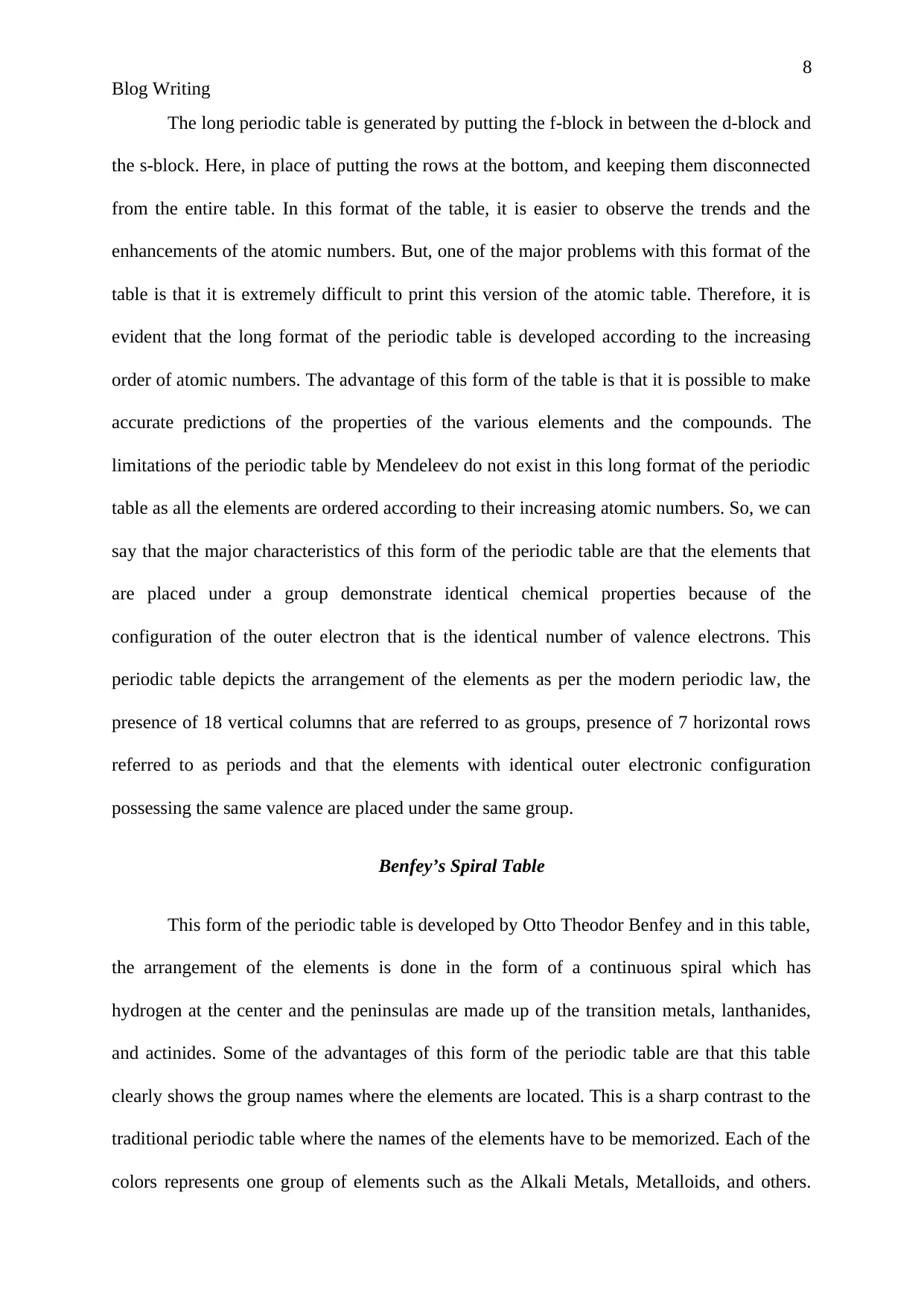
8
Blog Writing
The long periodic table is generated by putting the f-block in between the d-block and
the s-block. Here, in place of putting the rows at the bottom, and keeping them disconnected
from the entire table. In this format of the table, it is easier to observe the trends and the
enhancements of the atomic numbers. But, one of the major problems with this format of the
table is that it is extremely difficult to print this version of the atomic table. Therefore, it is
evident that the long format of the periodic table is developed according to the increasing
order of atomic numbers. The advantage of this form of the table is that it is possible to make
accurate predictions of the properties of the various elements and the compounds. The
limitations of the periodic table by Mendeleev do not exist in this long format of the periodic
table as all the elements are ordered according to their increasing atomic numbers. So, we can
say that the major characteristics of this form of the periodic table are that the elements that
are placed under a group demonstrate identical chemical properties because of the
configuration of the outer electron that is the identical number of valence electrons. This
periodic table depicts the arrangement of the elements as per the modern periodic law, the
presence of 18 vertical columns that are referred to as groups, presence of 7 horizontal rows
referred to as periods and that the elements with identical outer electronic configuration
possessing the same valence are placed under the same group.
Benfey’s Spiral Table
This form of the periodic table is developed by Otto Theodor Benfey and in this table,
the arrangement of the elements is done in the form of a continuous spiral which has
hydrogen at the center and the peninsulas are made up of the transition metals, lanthanides,
and actinides. Some of the advantages of this form of the periodic table are that this table
clearly shows the group names where the elements are located. This is a sharp contrast to the
traditional periodic table where the names of the elements have to be memorized. Each of the
colors represents one group of elements such as the Alkali Metals, Metalloids, and others.
Blog Writing
The long periodic table is generated by putting the f-block in between the d-block and
the s-block. Here, in place of putting the rows at the bottom, and keeping them disconnected
from the entire table. In this format of the table, it is easier to observe the trends and the
enhancements of the atomic numbers. But, one of the major problems with this format of the
table is that it is extremely difficult to print this version of the atomic table. Therefore, it is
evident that the long format of the periodic table is developed according to the increasing
order of atomic numbers. The advantage of this form of the table is that it is possible to make
accurate predictions of the properties of the various elements and the compounds. The
limitations of the periodic table by Mendeleev do not exist in this long format of the periodic
table as all the elements are ordered according to their increasing atomic numbers. So, we can
say that the major characteristics of this form of the periodic table are that the elements that
are placed under a group demonstrate identical chemical properties because of the
configuration of the outer electron that is the identical number of valence electrons. This
periodic table depicts the arrangement of the elements as per the modern periodic law, the
presence of 18 vertical columns that are referred to as groups, presence of 7 horizontal rows
referred to as periods and that the elements with identical outer electronic configuration
possessing the same valence are placed under the same group.
Benfey’s Spiral Table
This form of the periodic table is developed by Otto Theodor Benfey and in this table,
the arrangement of the elements is done in the form of a continuous spiral which has
hydrogen at the center and the peninsulas are made up of the transition metals, lanthanides,
and actinides. Some of the advantages of this form of the periodic table are that this table
clearly shows the group names where the elements are located. This is a sharp contrast to the
traditional periodic table where the names of the elements have to be memorized. Each of the
colors represents one group of elements such as the Alkali Metals, Metalloids, and others.
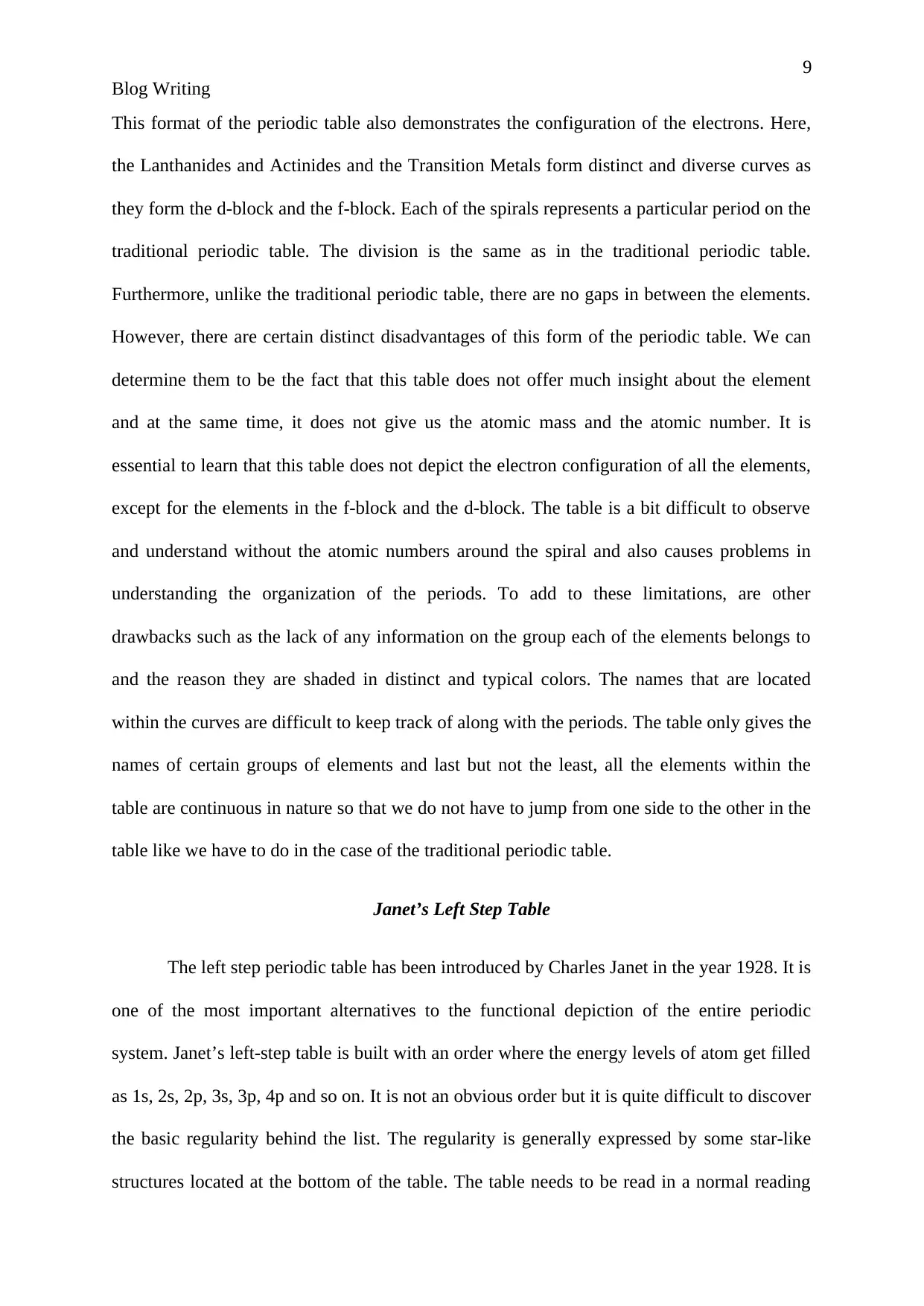
9
Blog Writing
This format of the periodic table also demonstrates the configuration of the electrons. Here,
the Lanthanides and Actinides and the Transition Metals form distinct and diverse curves as
they form the d-block and the f-block. Each of the spirals represents a particular period on the
traditional periodic table. The division is the same as in the traditional periodic table.
Furthermore, unlike the traditional periodic table, there are no gaps in between the elements.
However, there are certain distinct disadvantages of this form of the periodic table. We can
determine them to be the fact that this table does not offer much insight about the element
and at the same time, it does not give us the atomic mass and the atomic number. It is
essential to learn that this table does not depict the electron configuration of all the elements,
except for the elements in the f-block and the d-block. The table is a bit difficult to observe
and understand without the atomic numbers around the spiral and also causes problems in
understanding the organization of the periods. To add to these limitations, are other
drawbacks such as the lack of any information on the group each of the elements belongs to
and the reason they are shaded in distinct and typical colors. The names that are located
within the curves are difficult to keep track of along with the periods. The table only gives the
names of certain groups of elements and last but not the least, all the elements within the
table are continuous in nature so that we do not have to jump from one side to the other in the
table like we have to do in the case of the traditional periodic table.
Janet’s Left Step Table
The left step periodic table has been introduced by Charles Janet in the year 1928. It is
one of the most important alternatives to the functional depiction of the entire periodic
system. Janet’s left-step table is built with an order where the energy levels of atom get filled
as 1s, 2s, 2p, 3s, 3p, 4p and so on. It is not an obvious order but it is quite difficult to discover
the basic regularity behind the list. The regularity is generally expressed by some star-like
structures located at the bottom of the table. The table needs to be read in a normal reading
Blog Writing
This format of the periodic table also demonstrates the configuration of the electrons. Here,
the Lanthanides and Actinides and the Transition Metals form distinct and diverse curves as
they form the d-block and the f-block. Each of the spirals represents a particular period on the
traditional periodic table. The division is the same as in the traditional periodic table.
Furthermore, unlike the traditional periodic table, there are no gaps in between the elements.
However, there are certain distinct disadvantages of this form of the periodic table. We can
determine them to be the fact that this table does not offer much insight about the element
and at the same time, it does not give us the atomic mass and the atomic number. It is
essential to learn that this table does not depict the electron configuration of all the elements,
except for the elements in the f-block and the d-block. The table is a bit difficult to observe
and understand without the atomic numbers around the spiral and also causes problems in
understanding the organization of the periods. To add to these limitations, are other
drawbacks such as the lack of any information on the group each of the elements belongs to
and the reason they are shaded in distinct and typical colors. The names that are located
within the curves are difficult to keep track of along with the periods. The table only gives the
names of certain groups of elements and last but not the least, all the elements within the
table are continuous in nature so that we do not have to jump from one side to the other in the
table like we have to do in the case of the traditional periodic table.
Janet’s Left Step Table
The left step periodic table has been introduced by Charles Janet in the year 1928. It is
one of the most important alternatives to the functional depiction of the entire periodic
system. Janet’s left-step table is built with an order where the energy levels of atom get filled
as 1s, 2s, 2p, 3s, 3p, 4p and so on. It is not an obvious order but it is quite difficult to discover
the basic regularity behind the list. The regularity is generally expressed by some star-like
structures located at the bottom of the table. The table needs to be read in a normal reading
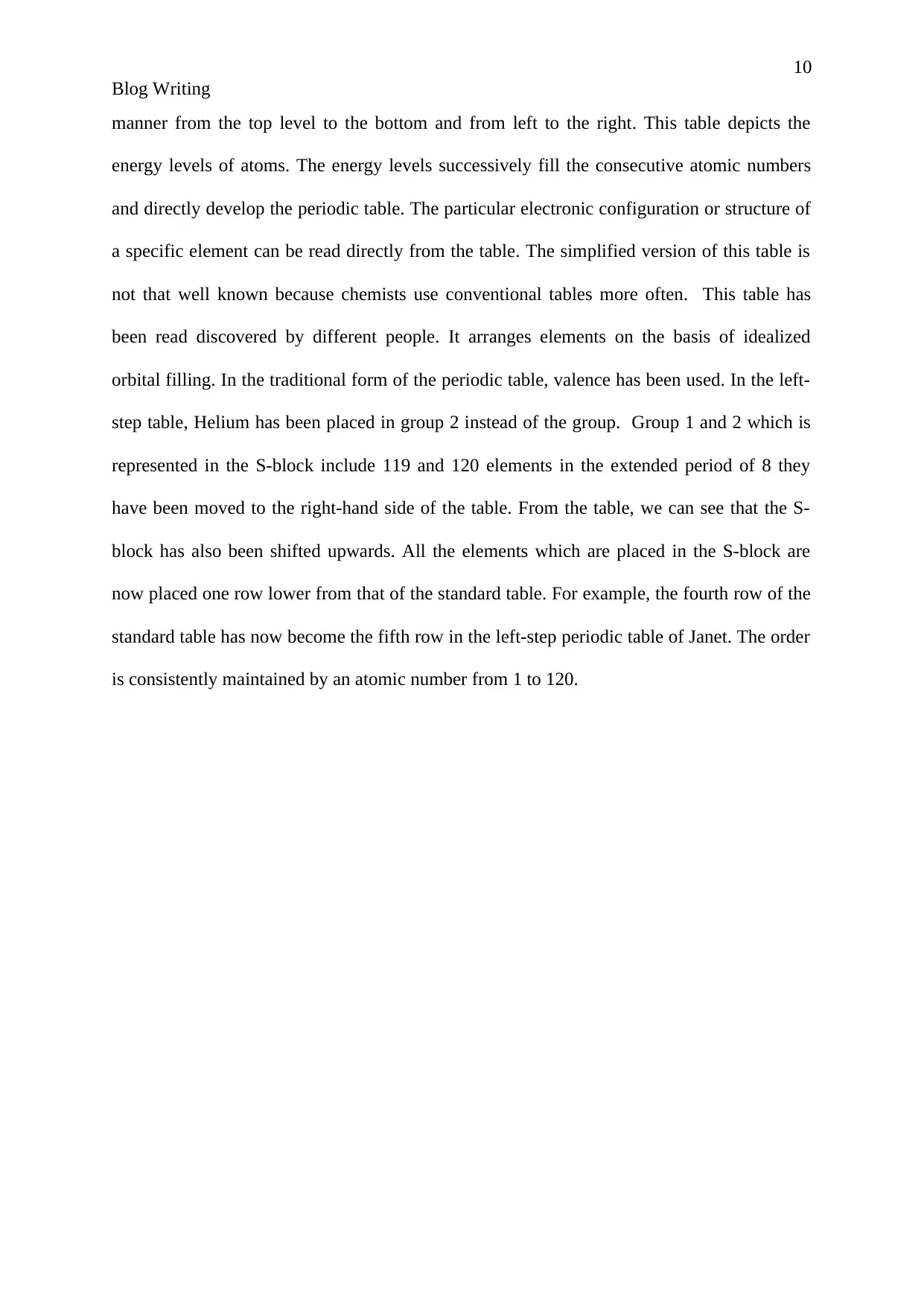
10
Blog Writing
manner from the top level to the bottom and from left to the right. This table depicts the
energy levels of atoms. The energy levels successively fill the consecutive atomic numbers
and directly develop the periodic table. The particular electronic configuration or structure of
a specific element can be read directly from the table. The simplified version of this table is
not that well known because chemists use conventional tables more often. This table has
been read discovered by different people. It arranges elements on the basis of idealized
orbital filling. In the traditional form of the periodic table, valence has been used. In the left-
step table, Helium has been placed in group 2 instead of the group. Group 1 and 2 which is
represented in the S-block include 119 and 120 elements in the extended period of 8 they
have been moved to the right-hand side of the table. From the table, we can see that the S-
block has also been shifted upwards. All the elements which are placed in the S-block are
now placed one row lower from that of the standard table. For example, the fourth row of the
standard table has now become the fifth row in the left-step periodic table of Janet. The order
is consistently maintained by an atomic number from 1 to 120.
Blog Writing
manner from the top level to the bottom and from left to the right. This table depicts the
energy levels of atoms. The energy levels successively fill the consecutive atomic numbers
and directly develop the periodic table. The particular electronic configuration or structure of
a specific element can be read directly from the table. The simplified version of this table is
not that well known because chemists use conventional tables more often. This table has
been read discovered by different people. It arranges elements on the basis of idealized
orbital filling. In the traditional form of the periodic table, valence has been used. In the left-
step table, Helium has been placed in group 2 instead of the group. Group 1 and 2 which is
represented in the S-block include 119 and 120 elements in the extended period of 8 they
have been moved to the right-hand side of the table. From the table, we can see that the S-
block has also been shifted upwards. All the elements which are placed in the S-block are
now placed one row lower from that of the standard table. For example, the fourth row of the
standard table has now become the fifth row in the left-step periodic table of Janet. The order
is consistently maintained by an atomic number from 1 to 120.
1 out of 10
Related Documents
Your All-in-One AI-Powered Toolkit for Academic Success.
+13062052269
info@desklib.com
Available 24*7 on WhatsApp / Email
![[object Object]](/_next/static/media/star-bottom.7253800d.svg)
Unlock your academic potential
© 2024 | Zucol Services PVT LTD | All rights reserved.





